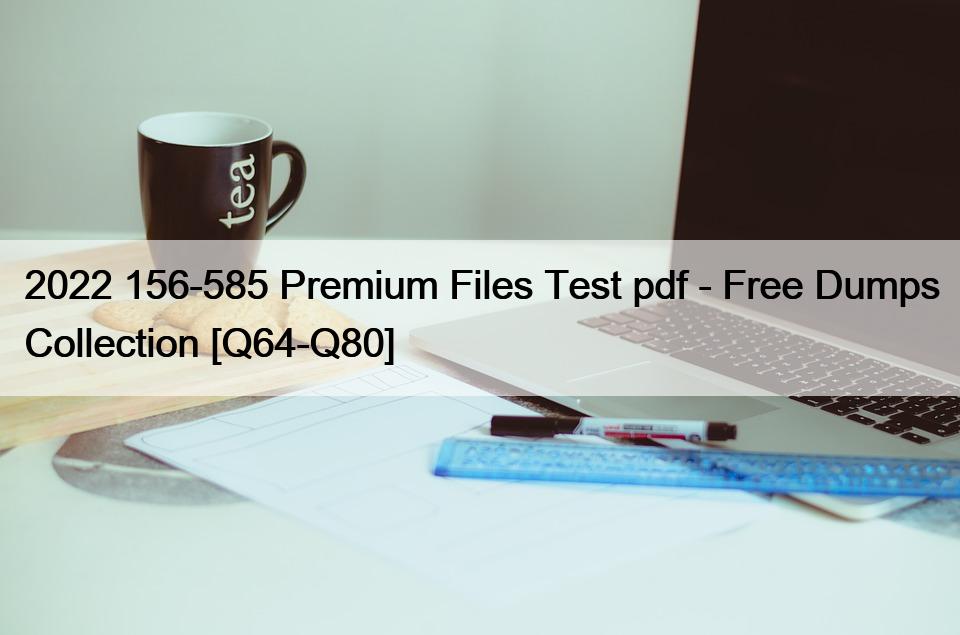[Mar-2022] Verified 156-315.80 dumps Q&As – 156-315.80 dumps with Correct Answers [Q95-Q111]
[Mar-2022] Verified 156-315.80 dumps Q&As – 156-315.80 dumps with Correct Answers
The Best CCSE Study Guide for the 156-315.80 Exam
Check Point 156-315.80 Exam Syllabus Topics:
| Topic | Details |
|---|---|
| CoreXL: Multicore Acceleration | – Supported Platforms and Features- Default Configuration – Processing Core Allocation – Allocating Processing Cores – Adding Processing Cores to the Hardware – Allocating an Additional Core to the SND – Allocating a Core for Heavy Logging – Packet Flows with SecureXL Enabled |
| Advanced VPN Concepts and Practices | – IPsec- Internet Key Exchange (IKE) – IKE Key Exchange Process – Phase 1/ Phase 2 Stages |
| SecureXL: Security Acceleration | – What SecureXL Does- Packet Acceleration – Session Rate Acceleration – Masking the Source Port – Application Layer Protocol – An Example with HTTP HTTP 1.1 – Factors that Preclude Acceleration – Factors that Preclude Templating (Session Acceleration) – Packet Flow – VPN Capabilities |
| Check Point Firewall Infrastructure | – GUI Clients – Management |
| SmartEvent | -SmartEvent Intro |
| FW Monitor | – What is FW Monitor- C2S Connections and S2C Packets fw monitor |
| Security Gateway | – User and Kernel Mode Processes- CPC Core Process -FWM – FWD -CPWD – Inbound and Outbound Packet Flow – Inbound FW CTL Chain Modules – Outbound Chain Modules – Columns in a Chain – Stateful Inspection |
| Advanced User Management | Objectives:
|
| Backup and Restore Security Gateways and Management Servers | – Snapshot management – Upgrade Tools – Backup Schedule Recommendations – Upgrade Tools – Performing Upgrades – Support Contract |
| Lab 1: Upgrading to Check PointR77 | – Install Security Management Server – Migrating Management server Data – Importing the Check Point Database – LaunchSmartDashboard – Upgrading the Security Gateway |
| Troubleshooting User Authentication and User Directory (LDAP) | – Common Configuration Pitfalls- Some LDAP Tools – Troubleshooting User Authentication |
| Lab 7: SmartEvent and SmartReporter | – Configure the Network Object in SmartDashboard- Configuring Security Gateways to work with SmartEvent – Monitoring Events with SmartEvent – Generate Reports Based on Activities |
| Clustering and Acceleration | – Clustering Terms- ClusterXL – Cluster Synchronization – Synchronized-Cluster Restrictions – Securing the Sync Interface – To Synchronize or Not to Synchronize |
| Upgrading Standalone Full High Availability | |
| Maintenance Tasks and Tools | – Perform a Manual Failover of the FW Cluster- Advanced Cluster Configuration |
| User Management | – Active Directory OU Structure- Using LDAP Servers with Check Point – LDAP User Management with User Directory – Defining an Account Unit – Configuring Active Directory Schemas – Multiple User Directory (LDAP) Servers – Authentication Process Flow – Limitations of Authentication Flow – User Directory (LDAP) Profiles |
| Lab 5: Configure Site-to-Site VPNs with Third Party Certificates | – Configuring Access to the Active Directory Server- Creating the Certificate – Importing the Certificate Chain and Generating Encryption Keys – Installing the Certificate – Establishing Environment Specific Configuration – Testing the VPN Using 3rd Party Certificates |
| Tunnel Management | – Permanent Tunnels- Tunnel Testing – VPN Tunnel Sharing – Tunnel-Management Configuration – Permanent-Tunnel Configuration – Tracking Options – Advanced Permanent-Tunnel configuration – VPN Tunnel Sharing Configuration |
| Identity Awareness | – Enabling AD Query- AD Query Setup – Identifying users behind an HTTP Proxy – Verifying there’s a logged on AD user at the source IP – Checking the source computer OS – Using SmartView Tracker |
| Management HA | – The Management High Availability Environment- Active vs. Standby – What Data is Backed Up? – Synchronization Modes – Synchronization Status |
| Advanced IPsec VPN and Remote Access | Objectives:
|
| Auditing and Reporting Process | -Auditing and Reporting Standards |
| VRRP | – VRRP vs ClusterXL- Monitored Circuit VRRP – Troubleshooting VRRP |
| Check Point Firewall Key Features | – Packet Inspection Flow- Policy Installation Flow – Policy Installation Process – Policy Installation Process Flow |
| VPN Debug | – vpn debug Command- vpn debug on | off – vpn debug ikeon |ikeoff – vpn Log Files – vpn debug trunc – VPN Environment Variables – vpn Command – vpn tu – Comparing SAs |
| Multiple Entry Point VPNs | – How Does MEP Work- Explicit MEP – Implicit MEP |
| Lab 3 Migrating to a Clustering Solution | – Installing and Configuring the Secondary Security Gateway Re-configuring the Primary Gateway – Configuring Management Server Routing – Configuring the Cluster Object – Testing High Availability – Installing the Secondary Management Server – Configuring Management High Availability |
| Troubleshooting | -VPN Encryption Issues |
| Kernel Tables | – Connections Table- Connections Table Format |
| Remote Access VPNs | – Connection Initiation- Link Selection |
| Advanced Firewall | Objectives:
|
| Lab 6: Remote Access with Endpoint Security VPN | – Defining LDAP Users and Groups- Configuring LDAP User Access – Defining Encryption Rules – Defining Remote Access Rules – Configuring the Client Side |
| SmartEvent Architecture | – Component Communication Process- Event Policy User Interface |
| Lab 2: Core CLI Elements of Firewall Administration | – Policy Management and Status- Verification from the CLI – Using cpinfo – Run cpinfo on the Security Management Server – Analyzing cpinfo in InfoView – Using fw ctl pstat – Using tcpdump |
| Upgrading | Objectives:
|
| ClusterXL: Load Sharing | – Multicast Load Sharing- Unicast Load Sharing – How Packets Travel Through a Unicast – LS Cluster – Sticky Connections |
| Network Address Translation | – How NAT Works- Hide NAT Process – Security Servers – How a Security Server Works – Basic Firewall Administration – Common Commands |
| Auditing and Reporting | Objectives:
|
156-315.80 certification guide Q&A from Training Expert PassTestking: https://www.passtestking.com/CheckPoint/156-315.80-practice-exam-dumps.html
Related Links: edu.chaulerbazar.com lms5.droosak.com 15000n-11.duckart.pro 元亨天堂.官網.com szyitian.com.cn henrysc196.blogspothub.com


